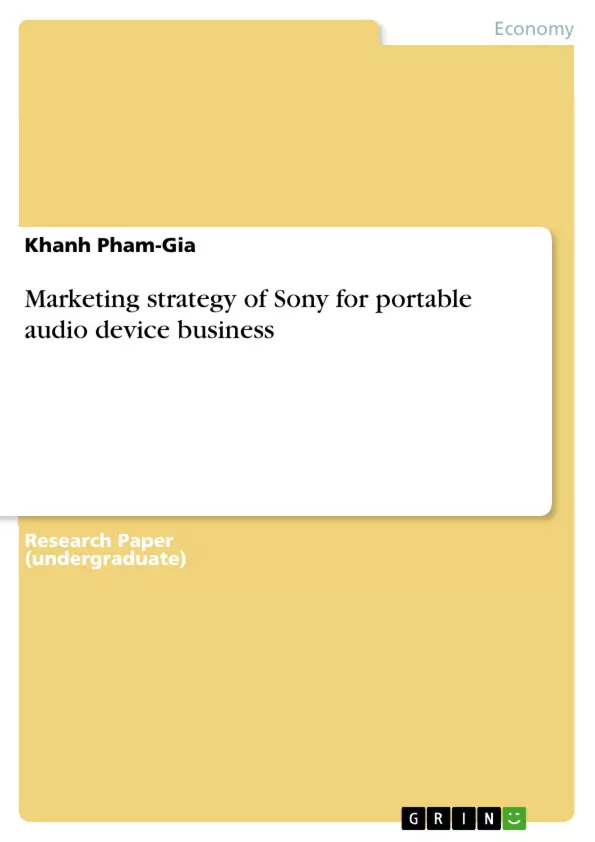Sony has a strong brand name and the company was successful with the Cassette, CD and MD Walkman in the 80s and 90s. However, the company missed the rapid development in the hard battled MP3 player market. In this study the Sony’s portable audio devices were analyzed by using Boston Consulting Group approach and Product Life-Cycle. Sony arranges now gradual phasing out of DOGs like Cassette, CD and MD Walkman and has a new challenge by growing the STAR MP3 Walkman. A benchmark of a current Sony’s MP3 player (Walkman NWZ-A818) to a competitor product (Apple’s iPod Touch) was accomplished. The “4 P’s” marketing mix method (Product, Price, Promotion and Place) was applied for the product comparison. Apple’s iPod scores in modern design with touch screen and multi-functionality while Sony’s Walkman convinces for excellent sound quality and high technical standards.
Moreover the Sony’s brand leverage strategy, in particular the brand extension strategy like category and line extension, was assessed. Despite of its strong brand name and high quality, Sony’s Walkman is out of the market leader and outrider role due to some failures: too late entry to the MP3 player market, strong focus only on technical features and missing out to make the MP3 player a fashion article. In the future, Sony has to maximize the market share in this growth stage. A proposed portable audio device for the future could be an all-in-one device with multi-functionality for multimedia.
“After a match is before a match” is a good slogan for the future. The winner is someone who has strength in speed, innovation and global impact. Sony should continue making innovation and expanding its demographic market as well as considering and fitting the customer needs.
Table of Contents
- Executive Summary
- Table of Contents
- List of Abbreviations
- List of Tables and Figures
- 1 Introduction
- 2 Main Part
- 2.1 Product analysis using BCG approach and PLC
- 2.1.1 Methodology
- 2.1.2 Analysis of Sony's portable audio device
- 2.2 Comparison between Sony's MP3 Walkman and Apple's iPod
- 2.3 Evaluation of Sony's brand leverage strategy
- 3 Conclusion
- 4 ITM checklist
Objectives and Key Themes
This study analyzes the marketing strategy of Sony for its portable audio devices, focusing on the company's response to the rapidly evolving MP3 player market. The study examines Sony's position in the market using the Boston Consulting Group (BCG) approach and Product Life-Cycle (PLC) analysis. It then compares Sony's MP3 Walkman to Apple's iPod Touch, assessing key marketing mix elements. The study also explores Sony's brand leverage strategy, highlighting its strengths and weaknesses in the competitive landscape. Key themes explored in this study include:- Sony's market position in the portable audio device market
- Analysis of Sony's product portfolio using the BCG matrix and PLC
- Comparison of Sony's Walkman with Apple's iPod Touch based on the marketing mix
- Evaluation of Sony's brand leverage strategy, including category and line extension
- Challenges and opportunities for Sony in the evolving portable audio device market
Chapter Summaries
The study begins with an introduction to the topic, outlining the context and significance of Sony's portable audio device business. The main part of the study delves into the analysis of Sony's product portfolio. Using the BCG matrix and PLC analysis, the study classifies Sony's products, including the Cassette, CD, MD Walkman, and MP3 Walkman, and assesses their current market positions. The study then compares the technical features and marketing strategies of Sony's MP3 Walkman and Apple's iPod Touch. It explores key marketing mix elements, including product, price, promotion, and place, and assesses the strengths and weaknesses of each device. The study then examines Sony's brand leverage strategy, analyzing its use of category and line extensions. Finally, the study concludes with a discussion of Sony's future challenges and opportunities in the portable audio device market. It proposes a vision for an all-in-one multimedia device and highlights the importance of innovation and customer needs in this evolving market.
Keywords
This study examines the marketing strategy of Sony's portable audio devices, focusing on the MP3 player market. Key topics include the Boston Consulting Group (BCG) matrix, Product Life-Cycle (PLC), marketing mix elements, brand leverage strategy, product comparison, and market analysis.- Citation du texte
- Dr. Khanh Pham-Gia (Auteur), 2007, Marketing strategy of Sony for portable audio device business, Munich, GRIN Verlag, https://www.grin.com/document/132246



